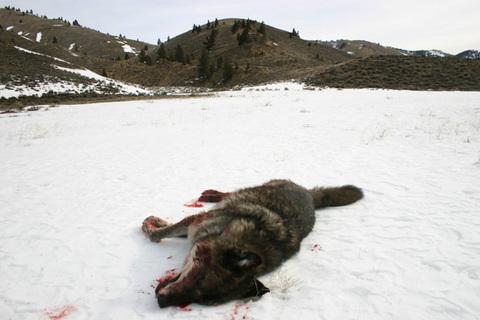Has Yellowstone National Park's wolf recovery program, now more than a decade old, succeeded? The federal government thinks so, as evidenced by the removal of greater Yellowstone wolves last month from the Endangered Species List. But a coalition of conservation group differs, and has filed a lawsuit to overturn the delisting.
Since wolves were returned to Yellowstone and central Idaho back in 1995, that seedstock has blossomed to roughly 1,500 animals. That's a lot of wolves, to say the least. But some biologists say a sound recovery program can't sustain itself, genetically, without two or three times that number.
Since the greater Yellowstone wolves lost ESA protection last month, nearly 40 have been killed in Montana, Idaho and Wyoming, according to an Associated Press report. Today the Natural Resources Defense Council, Defenders of Wildlife, Sierra Club, Center for Biological Diversity, The Humane Society of the United States, Jackson Hole Conservation Alliance, Friends of the Clearwater, Alliance for the Wild Rockies, Oregon Wild, Cascadia Wildlands Project, Western Watersheds Project, and the Wildlands Project sought a court order to overturn the delisting.
“Until now the reintroduction of gray wolves to the Northern Rockies was one of our greatest endangered species success stories,” said Louisa Willcox, director of the NRDC’s office in Livingston, Montana. “Now the region has become a killing field for wolves, just as we predicted. Dozens of wolves have been killed already, and more are certain to die under state laws that in many cases allow unregulated wolf killing anywhere, anytime, for any reason.”
The filing argues that the killings must stop while the court decides whether the government acted appropriately in delisting the predators. NRDC filed a petition in February requesting that the U.S. Fish and Wildlife Service establish legitimate targets for recovery of wolves throughout the lower 48 states.
In its petition, NRDC contends that the service failed to recover wolves on much of the available public lands where wolves formerly lived and ignored decades of scientific analysis. Without explanation or any scientific basis, the service set widely different recovery goals in the Midwest, Northern Rockies and Southwest regions, according to the group.
“The gray wolf simply hasn’t recovered yet. Every animal that falls victim to bait or bullet increases the odds that wolves will slide back toward extinction,” Ms. Willcox said.
Of course, a little hyperbole is in play here. The wolf is not in danger of going extinct any time soon, as evidenced by the packs that roam Canada and Alaska, not to mention Russia. But the health of the greater Yellowstone ecosystem just might be in play. After all, before wolves were returned to Yellowstone the park's elk herds had burgeoned, and in turn the ungulates beat down the spread and growth of aspen and willows, which some believe hampered growth of the park's beaver populations. Those are just the most obvious environmental cascades associated with the keystone predator's return. There are many more.
Then, too, there is the economic boost wolves have provided the communities surrounding Yellowstone. Tens of thousands of visitors flock to Yellowstone each year to see and hear wolves in the wild, contributing at least $35 million to the local economy each year, the coalition said.
Thousands of gray wolves roamed the Rocky Mountains before being slaughtered and eliminated from 95 percent of the lower 48 states by the 1930s. The gray wolf was listed as endangered under the Endangered Species Act in 1973. Reintroduction efforts placed 66 wolves in Yellowstone and part of Idaho in 1995-96.




Comments
Hey Anonymous, you may call Mr Saunders a skilled hunter but he had a cheap shot. Another words, unethical kill! If you peacock ranchers allow wildlife to have it's natural space to roam and breed and just maybe there can be some natural balance between predator and prey ratio. NOoooooo, we need more happy cows and more range land and will just smother out the rest of wildlife with cheap gun smoke. Don't tell me differently, I've seen this kind of scenario played over for years with you yahoo cowboys. Good cowboys know the wisdom of wise ethical hunting and don't expound by cheap cow talk or brag about a easy slaughter of wildlife.
I think that is terrible and horrible to watch or see no animal should be treated this way and you know humans are animals to so its like they are killing family a part of who you are! Its discusting
And to think them thar cowpokes are outsmarting you. Go figure?